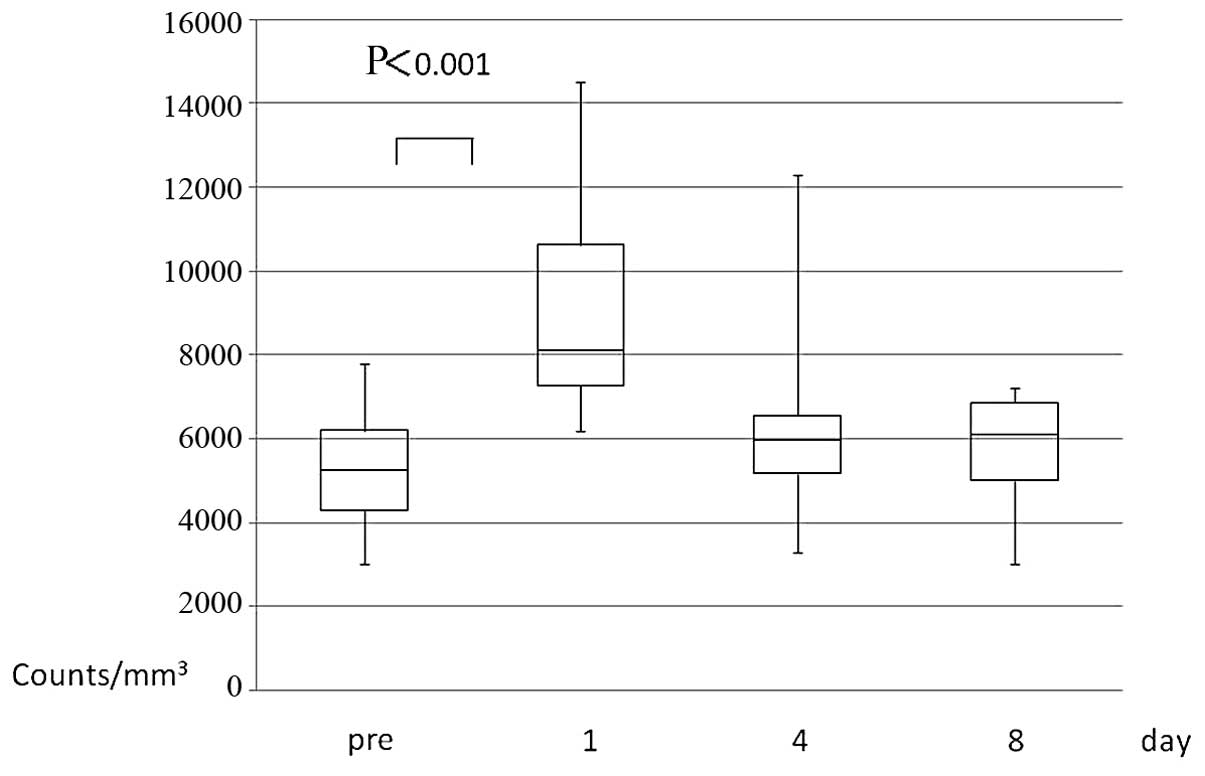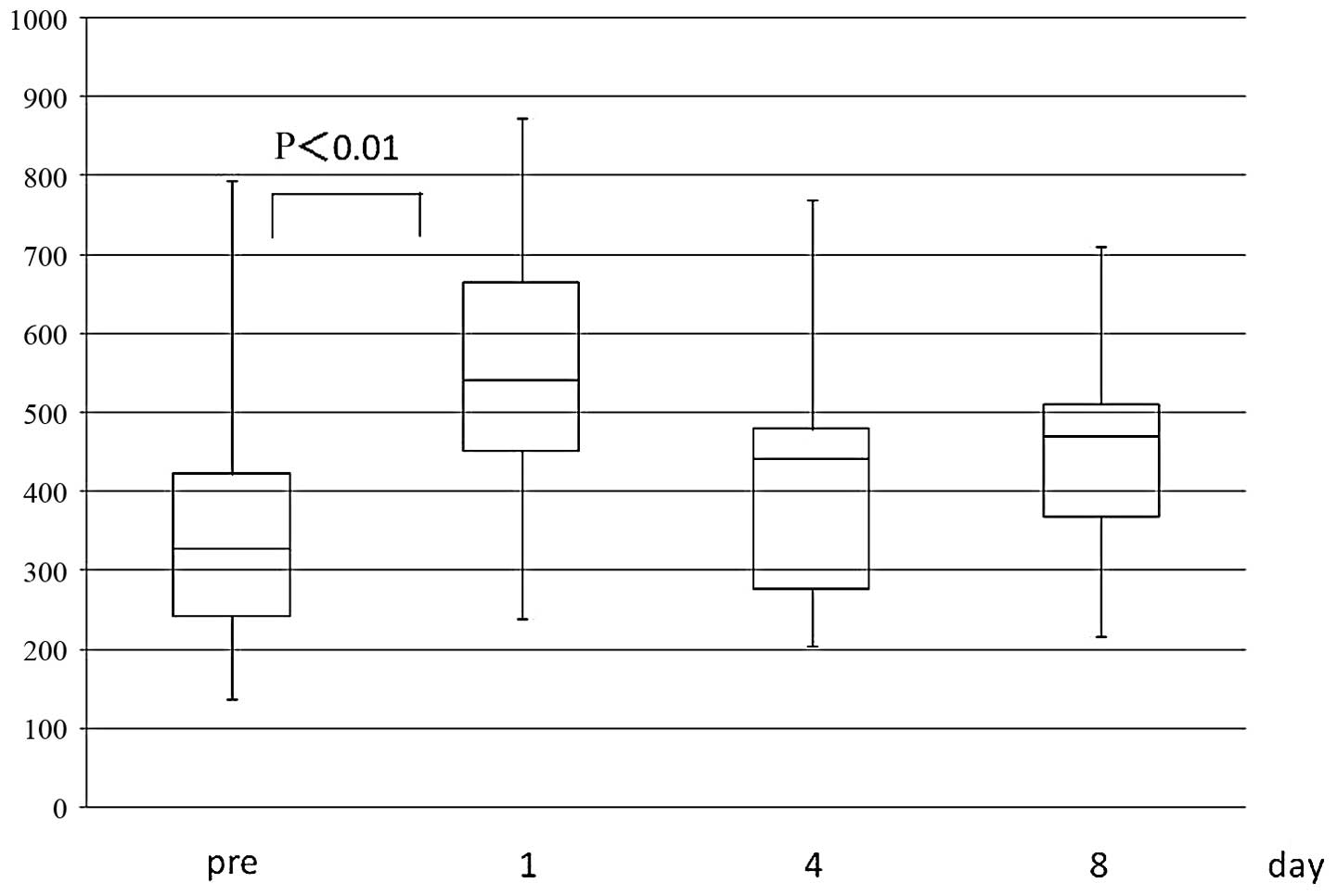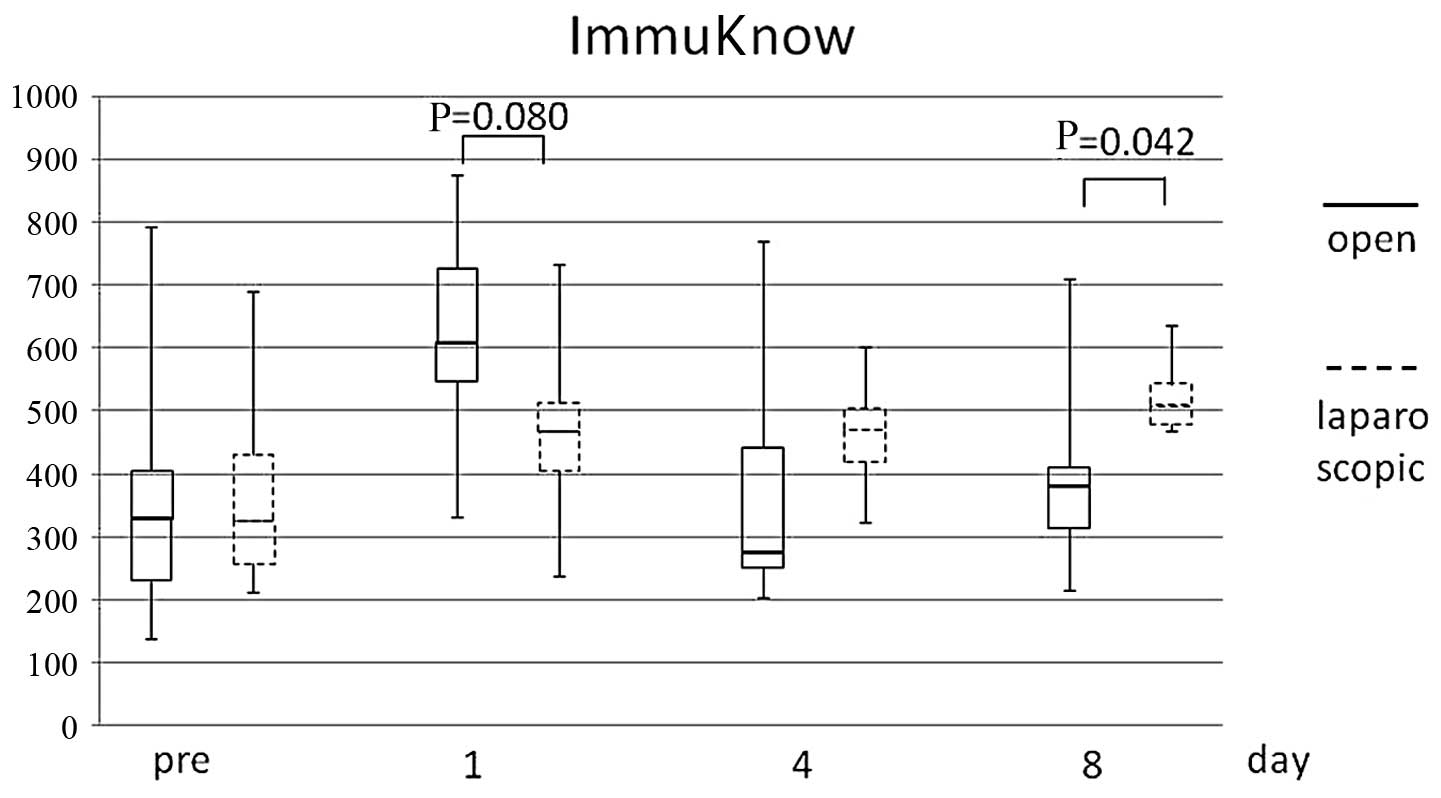
CD4+ T‑lymphocytes are activated by surgical stress following colorectal resection in cancer patients
- Authors:
- Kenji Maki
- Shinsuke Takeno
- Naoya Aisu
- Kanefumi Yamashita
- Masayasu Naito
- Seiichiro Hoshino
- Yuichi Yamashita
-
View Affiliations
Affiliations: Department of Gastroenterological Surgery, Faculty of Medicine, Fukuoka University, Fukuoka, Fukuoka 814‑0180, Japan
- Published online on: October 13, 2014 https://doi.org/10.3892/mco.2014.442
-
Pages:
79-82
Metrics:
Total
Views: 0 (Spandidos Publications: | PMC Statistics:
)
Metrics:
Total PDF Downloads: 0 (Spandidos Publications: | PMC Statistics:
)
This article is mentioned in:
Abstract
The aim of the present study was to measure adenosine triphosphate (ATP) levels in CD4+ T cells as a marker of T‑cell activity following surgery for colorectal cancer using the ImmuKnow assay kit. A total of 16 consecutive patients who underwent surgical resection for colorectal cancer between August and December, 2012 were enrolled in this study, of whom 7 underwent laparoscopic resection and 9 underwent open abdominal surgery. The intracellular ATP levels in CD4+ T‑lymphocytes were measured using the ImmuKnow assay kit preoperatively and on the 1st, 4th and 8th postoperative days, as were the white blood cell (WBC) count, lymphocyte count and C‑reactive protein (CRP) levels. The ATP level of the CD4+ T‑cells was significantly elevated on the 1st day following surgery compared to the preoperative level (P<0.01) and gradually returned to preoperative levels; the lymphocyte count was significantly decreased on the 1st postoperative day (P<0.001). In addition, the ImmuKnow assay demonstrated that only the ATP level, but not the WBC count, lymphocyte count or CRP level, exhibited a significant difference on the 1st (P=0.080) and 8th (P=0.042) postoperative days between the laparoscopic and open abdominal surgery groups. In conclusion, the ATP level of CD4+ T‑lymphocytes was increased in response to surgical stress, in tandem with a decrease in the lymphocyte count. Therefore, the ImmuKnow assay kit may be clinically applicable for monitoring the immune response following surgery, as it exhibits a higher sensitivity compared to other assays.
View References
|
1
|
Kowalski R, Post D, Schneider MC, et al:
Immune cell function testing: an adjunct to therapeutic drug
monitoring in transplant patient management. Clin Transplant.
17:77–88. 2003. View Article : Google Scholar : PubMed/NCBI
|
|
2
|
Kowalski RJ, Post DR, Mannon RB, et al:
Assessing relative risks of infection and rejection: a
meta-analysis using an immune function assay. Transplantation.
82:663–668. 2006. View Article : Google Scholar : PubMed/NCBI
|
|
3
|
Husain S, Raza K, Pilewski JM, et al:
Experience with immune monitoring in lung transplant recipients:
correlation of low immune function with infection. Transplantation.
87:1852–1857. 2009. View Article : Google Scholar : PubMed/NCBI
|
|
4
|
Xue F, Zhang J, Han L, Li Q, Xu N, Zhou T,
Xi Z, Wu Y and Xia Q: Immune cell functional assay in monitoring of
adult liver transplantation recipients with infection.
Transplantation. 89:620–626. 2010. View Article : Google Scholar : PubMed/NCBI
|
|
5
|
Hooper E, Hawkins DM, Kowalski RJ, Post
DR, Britz JA, Brooks KC and Turman MA: Establishing pediatric
immune response zones using the Cylex ImmuKnow assay. Clin
Transplant. 19:834–839. 2005. View Article : Google Scholar : PubMed/NCBI
|
|
6
|
Ogawa K, Hirai M, Katsube T, Murayama M,
Hamaguchi K, Shimakawa T, Naritake Y, Hosokawa T and Kajiwara T:
Suppression of cellular immunity by surgical stress. Surgery.
127:329–336. 2000. View Article : Google Scholar : PubMed/NCBI
|
|
7
|
Slade MS, Simmons RL, Yunis E and
Greenberg LJ: Immunodepression after major surgery in normal
patients. Surgery. 78:363–372. 1975.PubMed/NCBI
|
|
8
|
Wu FP, Sietses C, von Blomberg BM, van
Leeuwen PA, Meijer S and Cuesta MA: Systemic and peritoneal
inflammatory response after laparoscopic or conventional colon
resection in cancer patients: a prospective, randomized trial. Dis
Colon Rectum. 46:147–155. 2003. View Article : Google Scholar
|
|
9
|
Sobin LH, Gospodarowicz MK and Wittekind
C: TNM Classification of Malignant Tumours. 7th. John Wiley &
Sons; West Sussex: pp. 100–105. 2009
|
|
10
|
Vallina VL and Velasco JM: The influence
of laparoscopy on lymphocyte subpopulations in the surgical
patient. Surg Endosc. 10:481–484. 1996. View Article : Google Scholar : PubMed/NCBI
|
|
11
|
Brune IB, Wilke W, Hensler T, Feussner H,
Holzmann B and Siewert JR: Normal T lymphocyte and monocyte
function after minimally invasive surgery. Surg Endosc.
12:1020–1024. 1998. View Article : Google Scholar : PubMed/NCBI
|
|
12
|
Bessler M, Whelan RL, Halverson A, Treat
MR and Nowygrod R: Is immune function better preserved after
laparoscopic versus open colon resection? Surg Endosc. 8:881–883.
1994. View Article : Google Scholar : PubMed/NCBI
|















